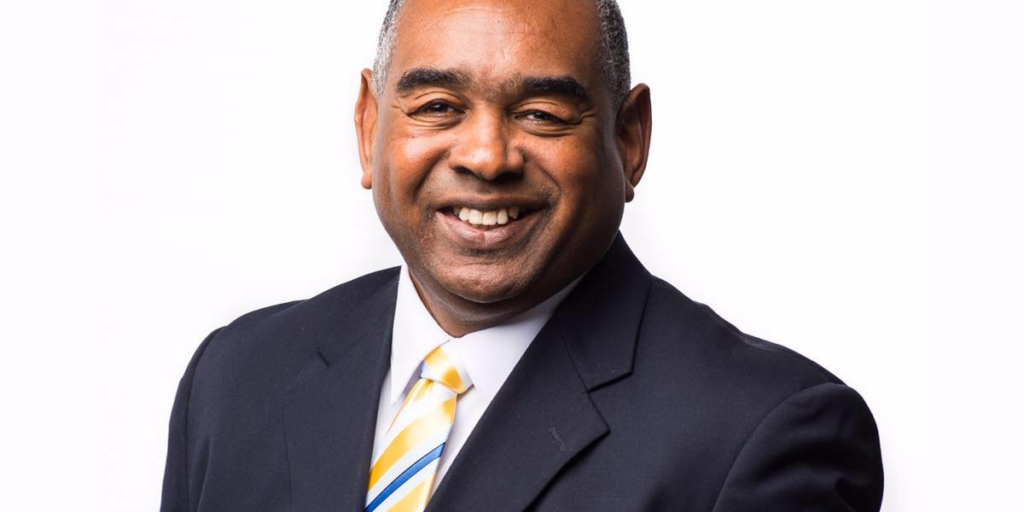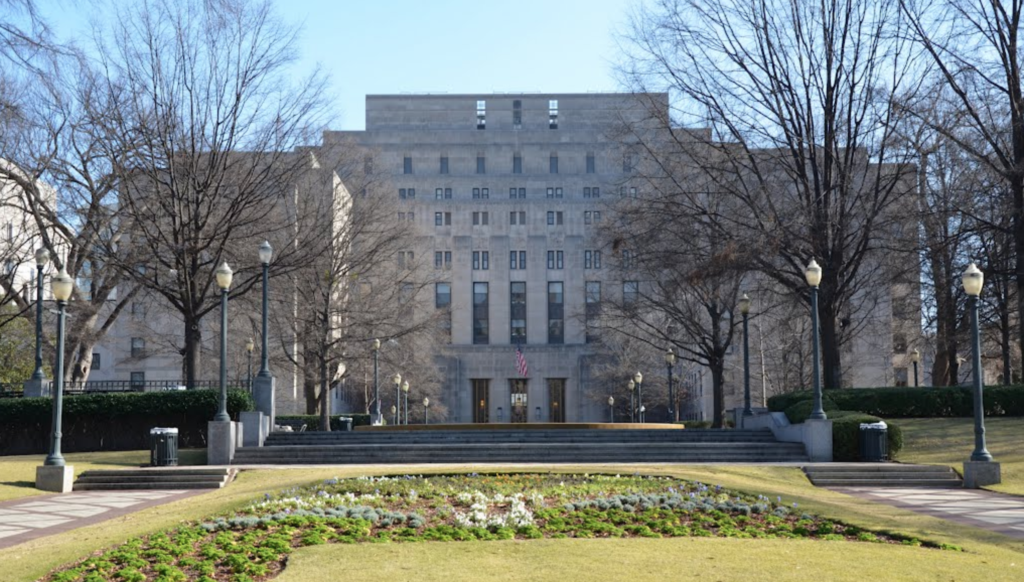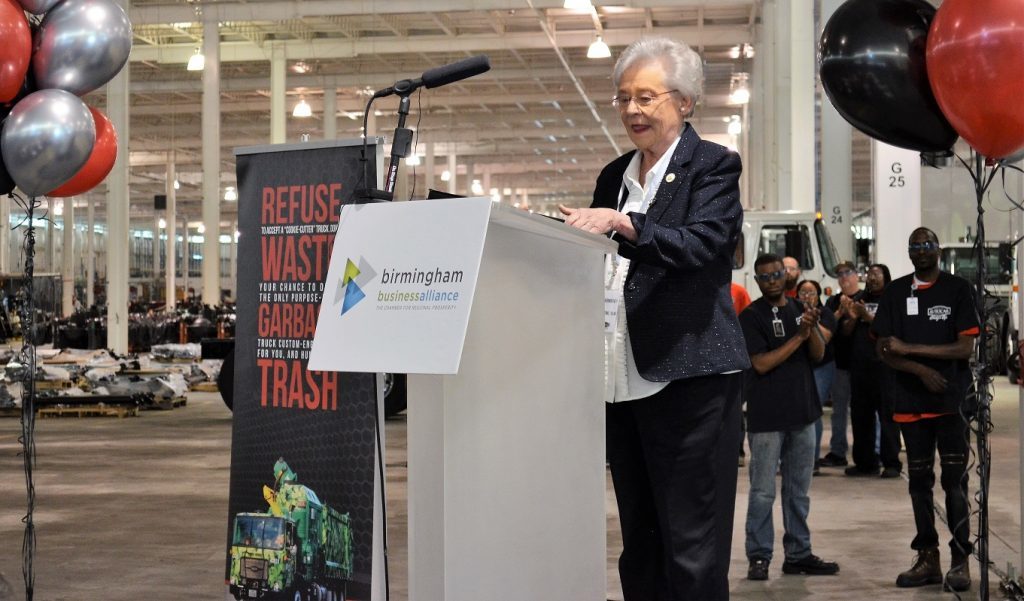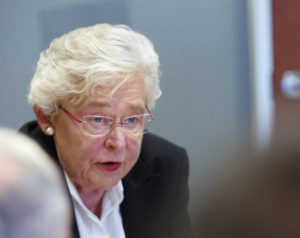Jefferson County to require face masks in public amid spike of COVID-19 cases

Following a statewide spike in coronavirus cases, Jefferson County on Friday announced a new county-wide ordinance that requires face masks to be worn public effective Monday, June 29, at 5 p.m. The ordinance comes from Jefferson County Health Officer, Dr. Mark Wilson. “We are at a place here in the last couple of weeks where it looks like we probably had more virus circulating in the general population than we had since the beginning,” Wilson told the Jefferson County Mayor’s Association last week. Read the complete ordinance below:
Sherry Lewis avoids prison on corruption conviction

Jefferson County Circuit Judge Clyde Jones ordered Sherry Lewis during a hearing to pay fines of $30,000 and to perform 400 hours of community service for her conviction on felony ethics charges of using her position for personal gain. The sentence included a suspended prison sentence, and a statement from prosecutors said Lewis won’t have to serve time if she fulfills other aspects of her punishment. Lewis was convicted in October of using the position to obtain jobs for her son, football bowl tickets, lavish meals and alcohol from a contractor. Meanwhile, she voted for the contractor to receive inflated payments from the Birmingham Water Works Board, authorities said. A contractor and a subcontractor are awaiting trial. Republished with the Permission of the Associated Press.
Aerospace, automotive summits heading to Birmingham this week

Birmingham is hosting a pair of business summits this week that showcase Alabama’s growing automotive and manufacturing industries, providing participants with high-level networking opportunities and one-on-one meetings. The conferences are the Aerospace Innovative Technology Summit (AITS), held May 7-9, and the Automotive Advanced Technology Summit (AATS), held May 8-9. Both events are taking place at the Birmingham-Jefferson Convention Complex, with 200 companies expected to participate. The Alabama Department of Commerce is among the sponsors of the summits, which feature workshops, presentations and business-to-business meetings. “The automotive and aerospace industries are major drivers of economic growth in Alabama, and these business conventions in Birmingham offer a pathway for companies from across the country and around the world to seek new opportunities and understand how their peers are utilizing and advancing the latest technologies,” said Greg Canfield, secretary of the Alabama Department of Commerce. “Besides companies from Alabama and multiple U.S. states, an international presence representing 11 different countries is here to participate,” he said. “These summits bring a focus on innovation, which is critical to growing and sustaining these manufacturing sectors and placing Alabama in a leading role for the latest technologies.” Focusing on innovation The Aerospace Innovative Technology Summit targets the aerospace, space and defense industries, all with a significant presence in Alabama. With a focus on new technologies being deployed in the sector such as 3D metal printing, digitalization of manufacturing and cyber security, the event aims to connect leading companies and participants in the sharing of ideas in the application and development of these innovations in their businesses. To kick off the aerospace conference, Canfield will provide an overview of the industry sector in the state. Other scheduled speakers include R.G. “Corky” Clinton Jr. of NASA’s Marshall Space Flight Center, Nick Bowman of GKN Aerospace and Jeff Chang of Lockheed Martin. The Automotive Advanced Technology Summit will focus on advanced manufacturing and new technologies at use within an industry growing rapidly in Alabama. Scheduled speakers include Mark Brazeal of Mazda Toyota Manufacturing USA, Tom Shoupe of Honda of America Manufacturing, and Brad Newman of ZF Chassis Systems in Tuscaloosa. Also speaking is Chuck Ernst, a former Honda Alabama executive who now serves as manager of the Alabama Robotics Technology Park, a unique training facility in Decatur. “It is an honor to have Birmingham chosen as the site for both of these conventions,” said Brian Jennings, vice president of economic development for the Birmingham Business Alliance (BBA). “It speaks to Alabama’s prominence in both the aerospace and automotive industries, and we look forward to bringing so many people together to foster continued growth of both industries.” Joining the BBA and the Department of Commerce in supporting the business conferences are the City of Birmingham, Jefferson County, the Birmingham Airport Authority, the Alabama Automobile Manufacturers Association and the Alabama Community College System. Mayor Randall Woodfin said Birmingham is the ideal location for the events. “Now, more than ever, Birmingham is focused on bringing high-quality technology jobs to our city. The summit gives a great chance to identify innovative partners that share our commitment to the next generation of manufacturing in the aerospace and automotive industries,” Woodfin said. This story originally appeared on the Alabama Department of Commerce’s Made in Alabama website.
New black sheriff, court officer in Birmingham rethinking policing

Veteran Alabama law enforcement officer Mark Pettway grew up in a black neighborhood called “Dynamite Hill” because the Ku Klux Klan bombed so many houses there in the 1950s and ’60s. Now, after becoming the first black person elected sheriff in Birmingham – on the same day voters elected the community’s first black district attorney – Pettway sees himself as part of a new wave of officers and court officials tasked with enforcing laws and rebuilding community trust fractured by police shootings, mass incarceration, and uneven enforcement that critics call racist. In a state where conservative politicians typically preach about getting tough on crime, Jefferson County’s new sheriff ran and won on an alternative message. He favors decriminalizing marijuana, opposes arming school employees, supports additional jailhouse education programs to reduce recidivism and plans for deputies to go out and talk to people more often, rather than just patrolling. “Going forward we need to think about being smarter and not being harder,” said the Democrat Pettway, 54. While the nation’s law enforcement officers are still mostly white men, and groups including the American Civil Liberties Union and Black Lives Matter call for sweeping changes in the criminal justice system, minorities appear to be making gains nationwide. In Pettway’s case, strong turnout by African-American voters, combined with national concern over police shootings of unarmed people of color, helped him defeat longtime Sheriff Mike Hale, a white Republican, said professor Angela K. Lewis, interim chair of political science at the University of Alabama at Birmingham. Winners in other cities attributed their success to similar factors. Houston voters elected 17 black women as judges in the midterms. Even before the election, nearly the entire criminal justice system in the Georgia city of South Fulton, near Atlanta was run by black women, including the chief judge, prosecutor, chief clerk and public defender. They’re offering more chances for criminal defendants to avoid convictions through pre-trial programs and increased use of taxpayer-funded lawyers to protect the rights of the accused. Chief Judge Tiffany C. Sellers of South Fulton’s municipal court said officials also explain court procedures in detail to defendants, many of whom haven’t been in court before and are scared. “Black and brown people often feel disenfranchised from the system, and I want them to understand what is going on,” Sellers said. “At the end of the day they may not like what I did with their case, but at least they know I explained things to them.” Midterms voters in five North Carolina counties elected black Democratic sheriffs for the first time, including Gerald Baker in Wake County. He defeated a longtime Republican incumbent by campaigning on ending the county’s participation in a Trump administration program to detain people suspected of being in the country illegally and advocating for greater police accountability. The message resonated in a county where a deputy and two highway troopers were charged in the beating of a black man earlier this year. Kyron Hinton suffered injuries including a broken nose, multiple dog bites and a fractured eye socket. “If we make a mistake out here in the actions that we take then we should take responsibility for those things,” Baker said in an interview after the election. Yet despite gains by people of color, officials like Baker still represent a minority in U.S. law enforcement. A Justice Department report released in 2013 showed that law enforcement agencies had become more racially and ethnically diverse over a 26-year period, yet the nation’s overall law enforcement community remained overwhelmingly white and male. Local police departments, which typically patrol inside city police jurisdictions, were about 73 percent white, the report said. Sheriff’s offices, which usually patrol in less urban areas and often operate county jails, were even whiter, at about 78 percent white. The report said research found that African-American, Latino and Asian-American communities were all underrepresented within police agencies relative to the populations they served. The disparity was greatest among blacks in areas where black population is proportionately largest, said the report. In Birmingham, Sheriff-elect Pettway of Jefferson County said he wants to increase hiring among minorities and women after he takes office in January. The department’s roughly 680-person staff should better reflect the county’s population, which is almost evenly split between blacks and whites, he said. Some of Pettway’s positions track those of the National Organization of Black Law Enforcement Executives, with about 3,000 members in all levels of police work. The group opposes arming teachers and held a conference last year aimed at broadening communication between police and community members. Pettway said he plans to increase the use of police body cameras, which he said was a big selling point during his campaign. “People loved that. With all the things that have been happening in law enforcement, people wanted accountability,” he said. Republished with permission from the Associated Press.
Understanding Jefferson County local amendment 1: raising tax limits

When Alabamians get to the polls on Tuesday, Nov. 6, voters in some counties will see local amendments on the ballot. Here’s a look at what residents of Jefferson County need to know about a local amendment they’ll see on the ballot: On the ballot: PROPOSED LOCAL AMENDMENT NUMBER ONE (1) Relating only to the City of Homewood in Jefferson County, proposing an amendment to the Constitution of Alabama of 1901, to provide that existing limits on the amount of ad valorem taxes payable on various classes of taxable property in any one year would not apply. (Proposed by Act 2018-166) Vote: Yes/No What it means: If passed, the amendment would allow Homewood, Ala. residents to vote on raising property taxes above the state lid at some point in the future. Sample ballot Click out the Jefferson County sample ballot: Front side | Back side Don’t live in Jefferson County? Find your county’s sample ballot here.
Disqualified candidate, party changes the latest in JeffCo judicial races

Judicial races are often pretty straight-forward, but they’ve been anything but that in Jefferson County as of late with a last minute disqualification and a candidate making a party switch. A disqualified candidate Last week, Fayette County Circuit Judge Samuel Junkin ruled Democratic candidate Linda Hall was ineligible to run in the Nov. 6 election for Circuit Court because she failed to meet the statutory residency requirements — having not lived in the county 12 months before the election. During her trial, Hall testified she does not live in Jefferson County. “I would not have ran if I knew that I lived in Shelby County,” she said. Despite being the party’s nominee, votes for Hall will essentially be null and void, as she is no longer eligible to win the seat. Secretary of State John Merrill explained should Hall earn more votes than her Republican opponent, incumbent Theresa Pulliam, the race will be void and Gov. Kay Ivey will then appoint someone to the seat for the two-year term. Party switch Jefferson County District Judge John Amari is also keeping things interesting in Jefferson County. On Friday, the Democratic judge sent a letter to the Chairman of the Jefferson County Republican Party asking him for permission to rejoin the Republican Party. In the letter, Amari stated, “I believe qualifications and experience matter in our judges. I feel so strongly about the qualifications, experience and character of Teresa Pulliam that I feel compelled to publicly endorse, actively campaign and vote for the Republican nominee.” Elected as a Democrat in 2008, Judge Amari decided to make the switch in order to publicly work for the election of Pulliam. JeffCo GOP Chairman Sallie Bryant welcomed Judge Amari back to the party. “Judge Amari is a man of high character who has ably served the people of our county with honor and dignity. We are pleased he will use his influence to help elect our local judicial candidates,“ Bryant said.
JeffCo Sheriff, DA candidates face-off in debate

Jefferson County voters have more information about the candidates running for Jefferson County Sheriff and District Attorney (DA) thanks to a public debate hosted Sunday evening. DA candidates, Republican incumbent Mike Anderton and Democrat challenger Danny Carr faced-off first, before the Sheriff candidates, incumbent Republican Mike Hale and Democrat challenger Mark Pettway took the stage at the UAB campus. The debate was hosted by the Birmingham Association of Black Journalists and the Phi Iota Omega Chapter of Alpha Kappa Alpha Sorority, Inc. the debate also featured a voter education session, which answered questions such as: What issues will be on the ballot? How do you navigate the Alabama Voter website to find your polling place? How to register to vote. And how to absentee vote. DA debate Crime and recidivism Anderton: “My primary goal is to work with those who have gotten in trouble before, try to figure out why they have gotten in trouble,” Anderton said according to the Birmingham Times. “Is it poverty? Is it lack of education? Is it lack of a job?. . . Let’s work with those who have recently gotten out of prison or jail. So that we can work with them to take care of whatever their needs are. Theirs are just as important. They’re coming out and needing our help. “What we’ve got to do is make sure they have some hope, make sure they’ve got something in their future that they can walk to with pride and know that when they get there they’ve accomplished something.” Carr: “Make sure that we do things that benefit those individuals while they’re paying for the crime that they committed,” Carr said according to the Birmingham Times. “The worst thing that could happen is that they go in and come out worse . . . because then they come in our community [and cause even more problems]. We have to . . . make sure that you are placing people in the best position they can be in when they get out so that they won’t return to a life of crime.” Watch the DA debate below: Sheriff debate Body cameras Both candidates agreed that body cameras protect sheriff deputies and citizens. “This day and age there is no reason why we should not have body cameras,” explained Pettway. Watch the Sheriff debate below:
Gates Foundation’s new school initiative awards $1.1M grant for JeffCo schools

Twelve schools in Jefferson County, Ala. are working together to improve 8th and 9th grade math through a Bill & Melinda Gates Foundation grant to the Southern Regional Education Board (SREB). The $1.1 million grant is one of 19 grants announced Tuesday by the foundation. SREB will use the grant to launch a network of 10 secondary schools that will focus on increasing the proficiency rates of Black, Latino, and low-income students on 8th grade math and 9th grade Algebra 1 in the Jefferson County part of Birmingham, Ala. “A poor start in high school math derails far too many students, but we can change that course if we find what works to prepare them,” said SREB President Stephen L. Pruitt. “By managing two networks — one urban and one rural — we will be able to learn and share critical lessons about improvement cycles within and across schools with similar challenges.” This summer, to understand the underlying causes of poor math performance, SREB began working with Jefferson County educators to collect data and conduct focus groups with students and teachers. Teams within and across schools are harnessing the power of the network to investigate problems and share solutions. Some have begun plan-do-study-act cycles to test strategies. Over time, promising solutions will be shared across the network to gather more data and further improve them. “We’re unpeeling the onion, figuring out why we’re not making progress, so teachers can find strategies for these individual students in these specific schools,” said Lauri Johnson, SREB organizational improvement director. “This is a singular opportunity to develop a continuous improvement mindset that focuses deeply on the needs of each student.” Urban and Rural Networks for School Improvement Jefferson County urban network schools Corner High School Corner Middle School Minor Middle School Minor High School Bragg Middle School Erwin Middle School Gardendale High School Oak Grove High School Irondale Middle School Shades Valley High School Hueytown High School Center Point High School Rural network 10 schools to be announced in late 2018 SREB and Jefferson County have partnered since 2015 on school improvement strategies across the district’s middle and high schools.
Good-paying jobs spur growth in Alabama’s Jefferson County

More than 3,500 jobs have been recruited to Jefferson County in the past 12 months and officials expect that number to increase by year’s end. “I expect another 200-job announcement soon and we’re a finalist in another more-than-a-1,000-job project that could be announced later this year,” said Jefferson County Commissioner David Carrington, chair of the Finance, Information Technology and Business Development Committee. In the past 60 days, the county has taken part in three major announcements: Amazon’s $320 million advanced robotics fulfillment center that will employ a minimum of 1,500 full-time employees; DC BLOX’s data center campus that is projected to result in $785 million in capital investment over the next 10 years; and Shipt’s decision to keep its corporate headquarters in Birmingham, adding another 881 employees. That’s in addition to recent announcements by Autocar, Evonik, Grupo Antolin, Iberia Bank, Pack Health and others. “It’s important to note that these projects are spread throughout the county in both unincorporated and incorporated areas: from Birmingham to Hoover and from McCalla to Center Point,” Carrington said. “These are good-paying jobs in diverse industries: from banking to advanced manufacturing and from distribution to technology. Salaries will range from $30,000 to more than $100,000.” Carrington pointed out that Shipt and Pack Health were started in Birmingham and are indicative of a budding technology ecosystem. Commission President Jimmie Stephens said he believes the county, after years of stagnation in some areas, has “turned the corner.” One reason is the collaboration among area leaders. “Teamwork is key to continued success,” he said. “We are stronger when we work together because our combined assets are greater than other competing areas. We just need to continue to communicate with one another and coordinate our actions and success will follow.” He added: “Communication with prospective prospects has been key along with matching vocational education opportunities to specific industry needs. Our workforce is diverse and is capable of meeting the needs of most industry needs. … We must market our area, tout our strengths and continue to demand excellence from our leaders.” The benefits of job growth go beyond the Birmingham metro area. “There is little down-side to more, better-paying jobs,” Carrington said. “They are the key to a healthier, growing community, more opportunities for our young people, fewer crimes, and higher government revenues without raising taxes.” Republished with permission from the Alabama NewsCenter.
Jefferson County leaders find bond market `very forgiving’ five years after bankruptcy

For localities worried about facing big bond-market penalties if they go bankrupt, consider Jefferson County. The county of 659,000 people – once the largest municipality to ever seek bankruptcy protection – has sold debt several times since emerging from court protection in 2013. Carrying an investment-grade rating of AA- in May, the county completed a refinancing of its general-obligation debt by paying yields of 2.86 percent on bonds due in 2026, just about half a percentage point above top-rated debt. “We were told our children would be destined to poverty, you were going to be the hole in the donut, you will never recuperate,” County Commissioner David Carrington said. He said the county’s bond deals have even seen strong demand from investors. “The markets are very forgiving if you have results.” Municipal-bond market analysts – and even investor Warren Buffett – have long worried that the fading stigma of bankruptcy could embolden more local governments to petition the court to cut their debts. But despite a few municipal bankruptcies in the wake of the last recession, there’s been little sign that more will follow suit. No city or town has filed for bankruptcy protection since Hillview, Kentucky, did in 2015 as a result of an adverse ruling in a contract dispute that it couldn’t afford to pay. Rather than let its capital go bankrupt, debt-strapped Connecticut agreed to pay off some of Hartford’s debts instead. While Jefferson County has gotten market access and its investment-grade rating back, the process was far from painless. Contending at the same time with revenue lost when a court struck down a key tax, it fired 1,300 employees, put off roadwork and shuttered inpatient services at its hospital that cared for the poor. To exit bankruptcy, officials agreed to raise sewer rates 8 percent annually through October 2018, followed by yearly jumps of 3.5 percent until 2053. Creditors, including JPMorgan Chase & Co., forgave $1.4 billion of debt. “You have to get to that point where there is no other alternative,” Carrington said. He said he’s been contacted by elected officials who are considering bankruptcy and has told them there is a “huge” financial burden. He said it cost the county about $1 million per month during the two years it took to get through the bankruptcy process. “Do you have the political will as a governing body to make the decisions you’re going to have to make?” he asked. Detroit, which followed Jefferson County with a bankruptcy filing in 2013, exited state financial oversight this year but still hasn’t returned to the bond market on its own. Mammoth Lakes, California, which sought bankruptcy protection in 2012 after a fight with a real estate developer, sold $24 million in investment-grade bonds in October 2017 that priced at a top yield of 4.47 percent in 2035, more than 1.8 percentage points above top-rated debt. In the years since the bankruptcy, the town has cut expenses and grown its revenues, S&P Global Ratings said. Local bankruptcies have been deterred because of the barriers to filing and the improving economy, said Henry Kevane, managing partner at law firm Pachulski Stang Ziehl & Jones LLP that specializes in such cases. Some states, including Illinois, don’t allow municipalities to file for Chapter 9, and others require permission from the governor. Still, municipalities face financial pressure points, he said. State and local governments’ unfunded pension liabilities stand at around $1.8 trillion, according to Federal Reserve data, which will require them to boost their payments into retirement funds. “Municipalities still have colossal post-employment obligations that aren’t going anywhere,” Kevane said. “I still see that becoming a real problem.” Republished with the permission of the Alabama Newscenter.
Jefferson Co. Commissioner, breast cancer survivor Sandra Little Brown highlights local breast cancer partnerships

Three years after Jefferson County Commissioner Sandra Little Brown fought her own battle with breast cancer and won, she’s still working to help increase awareness about the life-threatening disease. On Friday, she joined forces with St. Vincent’s Health System to host a community breakfast to highlight local partnerships that are doing their part in helping improve breast cancer awareness, research and care in the Birmingham metro area. Speakers at the event included: Veronica Wehby-Upchurch | Executive Diector of Susan G. Komen North Central Alabama Dr. Bo Xu | Chair of the Oncology Department at Southern Research Beth Bradner Davis | Executive Director of the Breast Cancer Research Foundation of Alabama Susan Sellers | President of St. Vincent’s Foundation Caroline McClain | Manager of Forge Breast Cancer Survivor Center Brenna Powell | Chief Strategy officer at St. Vincent’s Health System. Local partnerships The program highlighted the work of Forge Breast Cancer Survivor Center, which is a collaboration between all Birmingham area hospitals, the Community Foundation of Greater Birmingham, and other community partners. Forge’s creation was first announced in 2014. “This program brings together Birmingham’s wonderful healthcare resources with the goal of improving support and care for all people who have been diagnosed with breast cancer,” said Caroline McClain, manager of Forge Breast Cancer Survivor Center ahead of the event. “Forge works locally and in rural communities to remove barriers to care and gaps in service; navigate survivors and their families through diagnosis, treatment, and beyond; and support and educate healthcare professionals. Forge is constantly evolving to meet the ever-changing needs of survivors, their families, and the health systems. We are proud to provide exactly what they need, when they need it, and how they need it.” The event also highlighted two Birmingham-based entities: Southern Research and the Breast Cancer Research Foundation of Alabama, that are working to advance knowledge and develop new therapies for breast cancer. Susan G. Komen’s North Central Alabama chapter discussed its work with local organizations and individuals to raise awareness about breast cancer, which is one of the most common cancers among U.S. women. Breast cancer facts The American Cancer Society estimates that 266,120 women across the country this year will be diagnosed with invasive breast cancer and almost 41,000 will die from the disease. The Cancer Society estimates that 3,760 of those cases and 670 of those deaths will be in Alabama. Early detection and proper treatment can reduce the risk of dying from breast cancer. Over the past 20 years, progress in treatment and early detection has led to improved survival for people of all ages, races and stages of breast cancer. But experts say work remains to be done to ensure women are aware of the importance of regular screening and have access to tests that can find breast cancer early, when the chances of survival are highest. Increasingly, attention also has been focused on the importance of continued follow-up care even after breast cancer treatment has been completed. Survivors may need ongoing emotional support, and their treatment may leave them at higher risk of other conditions, such as heart disease, that require ongoing attention. “It’s exciting to see the work being done right here in our own community to meet all the needs – from raising basic awareness, to finding new treatments, to providing the best possible care over the long term,” said Brown. “There is more work to do, but we are making progress every day.”
Autocar holds grand opening at Birmingham area truck plant

The $120 million Autocar plant in Birmingham’s Pinson Valley cut the ribbon for an official grand opening today, but that doesn’t mean the factory hasn’t already been churning out trucks. “Our rapid growth meant we had to be up and running really fast,” said Andrew Taitz, chairman of Autocar. “We knew we could do it because of the people of Alabama and all of the great leaders of this state assured us that we would have partners on the road to building this fast. As you can see by looking around, when Alabamians make a promise, they keep it.” Autocar started producing trucks in September about the same time the plant formerly known only by the code name “Project Sunrise” was announced as an expansion of the Indiana-based Autocar. Autocar cuts the ribbon on $120 million Alabama truck plant from Alabama NewsCenter on Vimeo. “As you can see, Autocar has wasted no time in establishing its operations,” said Lee Smith, East Region CEO for BBVA Compass and 2018 chairman for the Birmingham Business Alliance (BBA). “The company is already building trucks for 46 states and provinces and plans to reach all 50 states from right here in Center Point.” Autocar was able to get off to such a fast start for a few reasons. First, it had an existing 1 million-square-foot facility in the former Meadowcraft plant that was large enough to accommodate its operations. Second, it worked closely with the Alabama Industrial Development Training (AIDT) program to get skilled and trained workers on board to begin production. Also, officials praised the team effort that included Birmingham, Center Point, Jefferson County, the BBA, the Alabama Department of Commerce, Alabama Power and others to make getting up and running easier. “This facility and this project is a prime example of regional cooperation,” Center Point Mayor Tom Henderson said. “The rewards of having this company and any of its suppliers in the future in our community will be realized by our citizens for many years to come.” Josh Carpenter, director of the Birmingham Office of Economic Development, noted that the city has a large industrial park next to the Autocar plant that would be a perfect place for suppliers. He said Autocar is a perfect fit for the metro area. “Birmingham is and has always been a city of builders, so it stands to reason that the biggest, baddest trucks in America should be built nearby,” Carpenter said. “I think this a great testament to what can be done with regional cooperation.” Autocar is expected to generate $645.1 million annually, which includes nearly $229 million to Alabama’s gross domestic product (GDP) and $130.1 million in earnings to Alabama households from 2,655 direct and indirect jobs, according to an impact study from the Center for Business and Economic Research at the University of Alabama’s Culverhouse College of Commerce. For the Birmingham metropolitan area, operations at the company will generate $600 million annually in economic impact, which includes $224 million contributed to the metro’s GDP and $123.9 million in earnings to households from 2,538 direct and indirect jobs. “Autocar already has a significant impact on Jefferson County, and will continue to do so with this new manufacturing plant,” Gov. Kay Ivey said. “By continuing to invest in Alabama, Autocar further proves that what we’re doing in our state is working. Autocar, and its expansion because of its success, is a fantastic representation of our commitment to help businesses not just survive but thrive.” Jim Johnston, president of Autocar, said the company’s hiring and production are running faster than expected. “We’re actually way ahead of schedule,” he said. Johnston said for now the plant is producing only its refuse cab-over-engine line of trucks but will add other models within the year. For now, Autocar is using only one of the two Meadowcraft buildings, but Johnston anticipates at the rate they’re growing, it won’t be long before the other building will come into play.“That is for growth and we will use that as needed,” he said. “We expect that this was the right choice for growth for many years.” Jefferson County Commissioner Joe Knight said it’s good to see those buildings buzzing with activity again. “It is indeed refreshing to see the resurrection of this icon of a building together with its new owner that will now breathe new life into our community,” he said. Johnston said they already feel like a member of the community. “We’re proud to be part of this great Alabama family and look forward to building trucks, communities and dreams together,” he said. Republished with the permission of Alabama NewsCenter.


